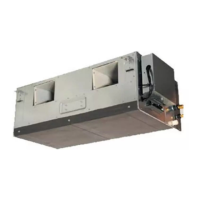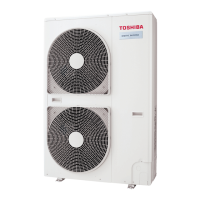What does a CPU-CPU communication error mean for my Toshiba RAV-SM1403DT-A?
- WWilliam CruzSep 7, 2025
A CPU-CPU communication error in your Toshiba Air Conditioner indicates a communication error between the main MCU and the motor microcomputer MCU.

What does a CPU-CPU communication error mean for my Toshiba RAV-SM1403DT-A?
A CPU-CPU communication error in your Toshiba Air Conditioner indicates a communication error between the main MCU and the motor microcomputer MCU.
What to do if my Toshiba RAV-SM1403DT-A Air Conditioner drainage is out of order?
If the drainage of your Toshiba Air Conditioner is out of order, check the drain pipe for any clogging. Also, inspect the float switch circuit and the indoor P.C. board.
What to do if my Toshiba Air Conditioner is not receiving data from the remote controller or network adapter?
If your Toshiba Air Conditioner is not receiving data from the remote controller or network adapter, check the remote controller, the network adapter, and the indoor P.C. board.
What does an IPDU communication error mean on my Toshiba RAV-SM1403DT-A Air Conditioner?
An IPDU communication error on your Toshiba Air Conditioner indicates a communication error between the IPDU and CDB.
What does abnormal external input into indoor unit (interlock) mean for my Toshiba RAV-SM1403DT-A?
If your Toshiba Air Conditioner shows an abnormal external input into the indoor unit (interlock), it indicates an abnormal stop due to incorrect external input into CN80.
What does an indoor address setting error mean on my Toshiba Air Conditioner?
An indoor address setting error on your Toshiba Air Conditioner means that there are two or more header units in the group.
What does an outdoor unit outside air temp. sensor error mean on my Toshiba Air Conditioner?
If your Toshiba Air Conditioner displays an error related to the outdoor unit outside air temp. sensor, it indicates an open-circuit or short-circuit of the outdoor air temp. sensor was detected, potentially due to the Outdoor P.C. board.
What does an indoor unit room temp. sensor (TA) error mean on my Toshiba RAV-SM1403DT-A?
If your Toshiba Air Conditioner displays an error related to the indoor unit room temp. sensor (TA), it indicates an open-circuit or short-circuit of the room temp. sensor (TA) was detected. The cause may be the Indoor P.C. board.
What does 'Indoor unit, other P.C. board error' mean on my Toshiba RAV-SM1403DT-A Air Conditioner?
If your Toshiba Air Conditioner displays an 'Indoor unit, other P.C. board error,' it indicates an EEPROM error, potentially related to the Indoor P.C. board.
What does it mean if my Toshiba Air Conditioner displays an outdoor unit discharge temp. error?
If your Toshiba Air Conditioner indicates an outdoor unit discharge temp. error, an error was detected in the discharge temp. releasing control.
| Brand | Toshiba |
|---|---|
| Model | RAV-SM1403DT-A |
| Category | Air Conditioner |
| Language | English |
Covers critical warnings for installation, operation, and repair/movement safety.
Covers important cautions for installation and operation safety.
Identification of parts for the indoor air conditioner unit.
Overview of the separate sold remote controller.
Identification of parts for the outdoor air conditioner unit.
Explanation of indicators and symbols on the remote controller display.
Description of buttons and functions in the remote controller operation section.
Steps to take before starting the air conditioner for the first time.
Procedures for initiating and safely stopping the air conditioner's operation.
Guide to setting up different timer modes for operation.
Instructions for canceling an active timer setting.
Steps to activate the power saving mode of the air conditioner.
How to disable the power saving mode.
Detailed instructions for configuring power saving settings.
Advice on maintaining efficiency and reducing energy consumption.
Understanding how the protective device stops operation and what to do.
Procedure for cleaning the air filters and resetting the indicator.
Guidelines for cleaning the remote controller safely.
Recommended checks for long-term use and preparing for storage.
Explanation of the 3-minute protection and power failure handling.
Details on preheating, warm air control, and defrosting.
Recommended temperature and humidity ranges for optimal performance.
Guidance on suitable and unsuitable places for installing the unit.
Precautions and requirements for electrical connections and grounding.
Steps to check before contacting service for common problems.
Explanations for noises, smells, or mist that are not actual failures.











